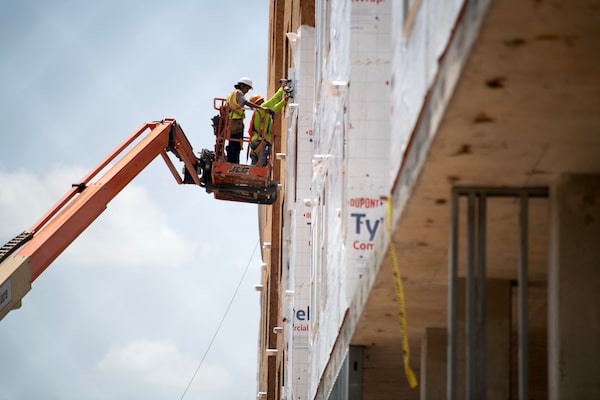
Construction workers put up house wrap during a heat wave in Houston on July 14. West Fraser Timber Co. Ltd.’s share price has risen more than 25 per cent since the start of June amid surprising strength in homebuilding activity in the U.S.MARK FELIX/AFP/Getty Images
West Fraser Timber Co. Ltd.’s WFG-T share price has rallied over the past several weeks amid surprising strength in homebuilding activity in the United States and renewed hope that the economy could skirt a recession – key conditions for lumber producers.
But this upbeat backdrop now puts a lot of pressure on the B.C. lumber producer’s upcoming quarterly financial report, which will be released on July 26. West Fraser’s share price has risen more than 25 per cent since the start of June, putting it near the top of its recent trading range over the past year and leaving little room for disappointment.
The gains follow a topsy-turvy environment for lumber: from shortages and record-high prices two years ago, to a near-collapse over the past 12 months as the lumber market reacted to soaring interest rates, an unsettled U.S. housing market and fears of an oncoming recession.
The Random Lengths framing lumber composite price – for the wood used in homebuilding – rose above US$1,500 per thousand board feet in May, 2021, or about three times its previous record price before the COVID-19 pandemic. The price at the start of June was below US$400.
West Fraser’s share price has also hopped around, slumping 27 per cent from a recent high above $125 in August, 2022, to a recent low of $91.50 at the start of June. Since then, though, the shares have embarked upon an impressive rebound, rising to $114.68 on Friday and putting the price within striking distance of a new peak.
Can the stock claw its way higher?
The recent strength follows surprisingly robust U.S. homebuilding activity, which has a big influence on lumber pricing and B.C. forestry stocks.
In May, U.S. homebuilders began work on more than 1.6 million homes, at an annualized rate, marking a 21.7 per cent increase from April and the highest level in more than a year. As well, building permits – which signal future building activity – rose an impressive 5.2 per cent after slumping in April and May.
The report for June, released this week, showed some moderation: homebuilding starts eased to 1.43 million; the previous month’s percentage increase was revised downward to 15.7 per cent; and gains in the number of building permits slowed to 3.7 per cent.
Still, investors in forestry stocks might have a few reasons to stay put.
For one, the odds of a U.S. recession are falling – to just 20 per cent over the next 12 months, according to an update from Goldman Sachs this week.
As well, builders are feeling more upbeat. The monthly National Association of Home Builders/Wells Fargo Housing Market Index, which gauges confidence among companies constructing lumber-intensive single-family homes has risen for six consecutive months.
U.S. inflation has tumbled to two-year lows and mortgage rates may have peaked last fall, bolstering the outlook for construction.
“As the Federal Reserve digests the latest inflation and labor market data, the housing market is diverging. Single-family construction is moving off cycle lows, while multifamily development is slowing after an unexpectedly strong run,” Robert Dietz, NAHB chief economist, said in a note this week.
The improving backdrop arrives at a time when analysts are growing more optimistic about the forestry sector amid rising prices for lumber and oriented strand board (or OSB, a variation on plywood).
“We believe that lumber’s upward momentum will continue to the fall, as buyers worry about potential lumber supply shortages amidst a record fire season in Canada,” Paul Quinn, an analyst at RBC Dominion Securities, said in a recent note.
John Duncanson, an analyst at Corton Capital’s Global Timber Fund, expects the outlook for the second half of this year will be very positive: Lumber prices have recovered about 20 per cent recently, while OSB prices bounced have increased by about 60 per cent.
“I am forecasting lumber to hit US$550 in the fourth quarter (up from current US$450) and OSB to hold most of its recent gains,” Mr. Duncanson said in an e-mail.
That’s good news for West Fraser, which produces both building materials.
Hamir Patel, an analyst at CIBC Capital Markets, raised his estimate for West Fraser’s 2023 EBITDA – earnings before interest, taxes, depreciation and amortization – by 52 per cent from his previous forecast.
Mr. Patel also raised his target price for the stock, or where he expects it will trade within 12 months, to $144 from $126 previously, supported by relatively strong U.S. homebuilding activity through 2024.
For West Fraser, the pressure is now on to meet these increasingly lofty expectations as the grim environment of rising interest rates and slowing economic activity gives way to something far more bullish: more homes.
 David Berman
David Berman